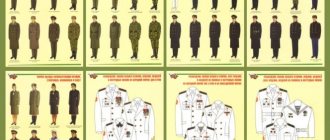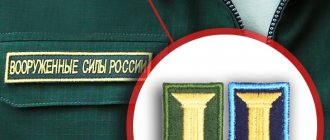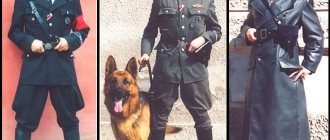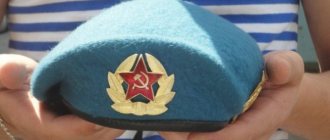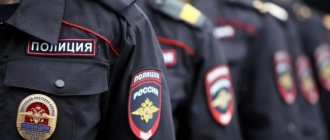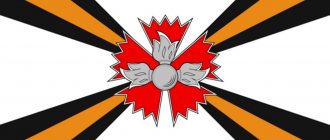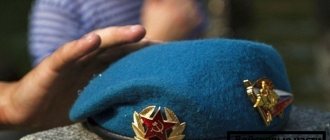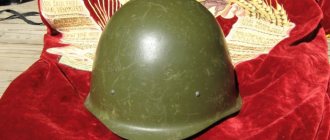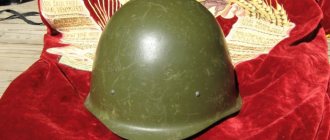New form of airborne forces in Russia
Now let’s travel through 2014 together with Russian Defense Minister Sergei Shoigu.
Not long ago he visited a legendary motorized rifle brigade, known since the Chechen war. In 2014, the soldiers of this unit were transferred to Ugra, and the new uniform acquired a new modern look, so now the military in such uniforms are not afraid of any frost. The new clothes were tested in extremely low temperatures, piercing and cold winds. Sergei Shoigu paid a visit to present awards, the action took place in an open area, and the military had to march in front of the highest leadership of Russia. At first, the form was delivered as an experimental one, but at the end of 2014 it was approved in 9 versions.
The new form for 2014 can be combined in different ways:
- for cool weather it will be enough to wear a lined jacket,
- for windy conditions it is recommended to wear a jacket under the jacket,
- in rainy weather, airborne special forces can wear a fleece shirt with a waterproof overall.
During the active training phase or the airborne assault march, the Airborne Forces wear their usual uniform. During theoretical classes, fighters wear lighter office attire.
The uniform of the Russian Airborne Forces in 2014 went through a number of changes: the ears on the earflap hat became longer, easily overlap at the back and are fastened with Velcro, this is quite important and comfortable for the chin. The hat has a top flap that can, if necessary, turn into a sun visor
Outerwear has also undergone many changes, for example, a jacket can be disassembled into several elements. It has become a kind of construction set that can be transformed from an ordinary windbreaker to a warm pea coat.
The entire 2014 field uniform consists of 16 pieces that easily fit into a backpack.
Depending on the time of year, the backpack can be light or heavy. In the new field footwear, felt boots were replaced by warm boots with inserts. A winter paratrooper vest has also been added, which does not restrict movement. A warm scarf and a comfortable balaclava were added to the whole set. Reconnaissance overalls are made of waterproof material.
PROCEDURE FOR WEARING PATCHES ON FIELD MILITARY CLOTHING
When our clients are interested in how to properly sew chevrons onto a new model military uniform of the Russian Armed Forces, we always provide the necessary information. Based on the decision of the Russian Minister of Defense, the wearing of sleeve and breastplates is permitted on field military uniforms of the existing type (winter (summer) camouflage suit with the “Number” color scheme).
The following chevrons are required to be placed on field military uniforms:
- Depending on whether you belong to specific types and branches of the Armed Forces, troops not included in this list and railway troops, you must use the size 6x4 cm. Location - in the center of the pocket of the left sleeve of the field jacket. Distance - 1 cm from the pocket flap. Color - protective (for the Navy - black).
- For the sleeve insignia with the State Flag in the shape of a rectangle, the size is 6x4 cm. The location is on the flap of the pocket of the left sleeve of the field jacket, in the center.
- Based on belonging to the military district, formation and association, the size is determined to be 7x8 cm. Location - in the center of the pocket of the right sleeve of the field jacket. Distance - 1 cm from the pocket flap. Color - protective (for the Navy - black).
- For the inscription “Russian Armed Forces” the required size is 12.5x2.5 cm, the height of the letters is 1 cm. Location is the flap of the right breast pocket of the field jacket, in the center. Color - protective (for the Navy - black).
If you need to make any stripes and chevrons for the uniform of military personnel of the Russian Army, please contact. Contact phone number in Moscow: 8 495 664-25-90, in Nizhny Novgorod: 88314657932. Delivery is possible to any location.
What do modern paratroopers wear?
The shape of the new airborne forces is based on the principle of multi-layering. Depending on weather conditions, military personnel are allowed to combine clothing:
- the modern uniform of the Russian Airborne Forces includes several combinations and sets of diverse clothing;
- in the cool season, soldiers are provided with an additional lined jacket;
- often military personnel from the special forces of the Airborne Forces are allowed to wear a jacket under their jacket;
- in rainy, damp weather, the uniform consists of an underwear fleece shirt and overalls with waterproof impregnation.
Thus, what uniform the airborne soldiers will have in a particular case is decided independently by the unit commander, taking into account weather conditions.
Additionally, the hat is equipped with a top flap, allowing it to turn inside out and transform into a visor. Felt boots were replaced with warm boots with thermal inserts. The outer jacket is a designer one and can easily be transformed from a windbreaker into a warm peacoat.
The new uniform set of the Russian Airborne Forces uniform for soldiers and field officers includes 19 items:
- several jackets;
- insulated vest;
- costume;
- three types of boots (summer, demi-season and winter);
- balaclava;
- mittens and gloves.
The summer uniform of the airborne special forces includes:
- underwear (T-shirt and boxer shorts);
- light jacket;
- trousers;
- cap (beret);
- summer boots.
To sew a lightweight version of the airborne uniform, a mechanical stretch treated with a water-repellent compound is used.
Winter uniform for the Airborne Forces option includes:
- two sets of insulated underwear (lightweight and fleece);
- demi-season suit;
- windproof suit;
- insulated vest;
- boots;
- balaclava.
In winter, it is allowed to wear a blue sweater under a jacket that is part of the uniform.
For hot climates, a separate set of uniforms for airborne troops was developed. The new uniform of airborne troops has a light brown or sandy color.
The first option consists of a short-sleeved shirt with a turn-down collar, shoulder straps, trousers and boots in a basic color. The headgear used is a soft cap similar to a baseball cap with a hard visor and a field cockade.
Shorts are allowed instead of trousers. Insignia on this type of uniform are placed similarly to everyday uniforms. This clothing option does not include award stripes. The second option consists of an elongated jacket with shoulder straps, trousers tucked into ankle boots. On the head is a cap or Panama hat that matches the statutory uniform.
The field uniform of an officer is exactly the same as that of the enlisted personnel of the Airborne Forces, only the dress clothes are different.
The ceremonial set of the Airborne Forces uniform consists of a blue jacket and trousers, a vest, a blue beret, aiguillette, white gloves and ankle boots.
Officer ceremonial uniform:
- blue jacket;
- untucked blue trousers;
- shirt;
- black tie;
- White gloves;
- black boots;
- gold aiguillette;
- blue cap with cockade.
The winter dress uniform of midshipmen and airborne officers includes a black jacket, a woolen cap or blue beret, a vest and combat boots. For enlisted personnel and cadets:
- gray hats with earflaps;
- demi-season blue jacket;
- costume;
- vest;
- beret.
Airborne special forces take part in the parade in field uniform. Not only shoulder straps, but also breast and sleeve stripes and chevrons are used as insignia. Before the collapse of the Soviet Union, the uniform was identical for all Airborne Forces employees, regardless of the republic.
Today, each country that was part of the USSR has its own version of the uniform. In the Russian Federation, the main ceremonial color of the Airborne Forces uniform is blue.
For example, not so long ago, the uniform of the highly mobile Ukrainian Airborne Forces was completely changed, in particular, the blue beret was removed from the military personnel’s clothing, replacing it with a similar purple-colored headdress. The main reason for this transformation is that in Russia the blue beret is an integral part of the Airborne Forces uniform.
In turn, in the Republic of Belarus the uniform of the special forces of the airborne special forces still includes a blue beret, as in Russia.
INSIGNIA
Military uniforms also require insignia. They are:
- Sleeves. An example is the insignia on the sleeves of the uniform of ship officers, depending on their military rank. They are horizontal braids of gold color and are sewn on the outer side of the sleeves of senior officers. The distance from the bottom of the sleeve to the first braid is 10 cm.
- Lapel. Such insignia of the branches and branches of the Russian Armed Forces are made of gold-colored metal. For senior military officers who have the ranks of justice and medical service, embroidered gold-colored buttonholes are required to be attached to their uniforms. Those military personnel (not counting the navy) for whom special lapel insignia were not installed wear elements of the Ground Forces. Metal tabs of khaki color must be attached to summer field jackets of special troops (services). And when the field uniform is worn as casual clothing, it is golden in color.
- Distinguishing insignia of military personnel. They are worn on the sleeves and chest. Chevrons are distinguished according to their belonging to the General Staff of the Armed Forces, the Ministry of Defense of the Russian Federation, types and branches of troops of the Russian Armed Forces, Railway Troops and those troops that are not included in the types and branches of troops of the Armed Forces of the Russian Federation. These patches are attached to the outside of the left sleeve (at the shoulder) of military clothing. Belonging to specific military formations is shown by chevrons sewn in the same place, only on the right sleeve of military clothing.
Examples of chest and sleeve patches on military uniforms
Figure 1. “Russian Armed Forces” patch on the chest (letters are 1 cm high).
Figure 2. Patch indicating the full name on a serviceman’s jacket.
Figure 3. Patch with the State Flag of the Russian Federation on the sleeve.
Examples of patches on the costumes of civil servants of the Ministry of Defense of the Russian Federation
Figure 4. “Russian Ministry of Defense” patch on the sleeve (letters are 1 cm high).
Figure 5. Patch indicating the full name on the soldier’s chest.
Summer option
The ceremonial version of the uniform of military personnel of the Russian Aerospace Forces, for cadets and enlisted personnel, of the summer type is a suit. It can be blue or khaki. Under his tunic, a private is required to wear a shirt of the same color, complemented by a tie with a gold tack. Officers are expected to wear a jacket and trousers of the same colors in combination with a white shirt and black tie. The cap of a VKS serviceman must be matched to the color of the suit. The set should include a gold belt.
The field version of the uniform for privates and cadets of the VKS, abbreviated as VKPO, is no different from the uniform version for the ground forces. The kit should include the following clothing items:
- short sleeve underwear;
- jacket with trousers;
- summer boots;
- cap;
- nude summer T-shirt.
Find out: What military ranks were there in the USSR army, what shoulder straps did the soldiers wear?
The office uniform for military personnel of the Russian Aerospace Forces differs in color from the uniform of other branches of the military. For military personnel of the military space forces it is blue. Otherwise, in style and details, it is similar to the uniform of other troops. Stripes and shoulder straps are issued in accordance with the serviceman's type of troops and his ranks.
The Armed Forces of the Russian Federation, like many armies of the world, have their own distinctive signs, including chevrons on military uniforms.
On June 22, 2015, based on the Decree of the President of the Russian Federation V.V. Putin on the modernization of military uniforms, Minister of Defense of the Russian Federation S.K. Shoigu issued Order No. 300 “On approval of the Rules for wearing military uniforms, insignia, departmental insignia and other heraldic signs in the RF Armed Forces and the Procedure for mixing items of existing and new military uniforms in the RF Armed Forces,” in accordance with which changes were made, concerning the appearance, color and location of sleeve insignia and breast patches for winter and demi-season casual jackets, for summer casual suit jackets, as well as field uniform jackets, except for wind- and waterproof suits.
According to the appendix to this order, the following has changed:
— the height of the sleeve insignia should be 100 mm and the width 85 mm, which is equivalent to the size of the textile fastener on the sleeves of military jackets;
— the background color of the sleeve insignia and chest patches must match the color of the top of the military uniform on which they are placed;
— chevrons of various branches of the military began to differ in the color of the edging and the established symbols; the borders also define the internal boundaries of the heraldic symbols;
— sleeve insignia located on the outer side of the left sleeve (corresponding to the type and branch of the troops of the RF Armed Forces) depicts the state flag of the Russian Federation of a rectangular shape, with side dimensions of 2x3. The emblem of the branch, branch of the military, or the established pattern must be placed under it;
— sleeve insignia located on the outer side of the right sleeve (belonging to a specific military formation) must display the heraldic symbols of the established pattern.
There have also been changes in office military uniforms:
- the height of the chest stripes is 125 mm, and the width is 25 mm;
- On the flap of the left breast pocket there is a patch with a yellow inscription containing the surname and initials of the serviceman, for example: “Petrov V.V. ", and edging of the established color;
- on the flap of the right breast pocket there is a patch with the yellow inscription “Armed Forces of Russia” and an edging of the established color;
- inscriptions and edgings of the chest patches on the jackets of the field uniform set in khaki color. If this set is used as an everyday uniform, stripes for everyday uniform are worn.
Military personnel wear badges of belonging to certain troops on the left side; they should be located 10 mm below the insignia of the Armed Forces, ribbons of state awards and other heraldic breastplates. If the above signs are absent, then the designation of belonging to a military formation is worn in their place.
Scheme of placement of official military symbols, insignia, personalized insignia and designations on the uniform (new sample) of military personnel
According to the rules, duty badges must be worn as follows on field and everyday uniforms:
- wool coat - on the left, the level of the top of the badge coincides with the level of the lapel corner
- wool peacoat - on the left side of the chest, the top of the badge is level with the second button from the top
- woolen jacket - the location of the badges on the jacket, except for the Navy jackets related to duty services, is associated with the level of the yoke, and if there are ribbons of medals or orders, they are shifted lower by 10 mm;
- blue woolen Navy jacket - on the breast pocket on the left side of the chest
- on field jackets and shirts - attached below the flap of the left breast pocket
- wool jacket or jacket black Navy, wool jacket - the upper part of the badge should be located 70 mm below the corner of the lapel, and if any
With this image, it has become easier to distinguish a serviceman of one military unit from another, looking at what chevron is on his military uniform. Above is an introductory photo of the location of the Russian Armed Forces chevron.
Scheme of placement of official military symbols, insignia, personalized insignia and designations on the uniform (new sample) of federal civil servants of the Ministry of Defense of the Russian Federation
Dembel uniform
The tradition of leaving for demobilization in a special uniform dates back to the times of the Soviet Union. This form was prepared in advance, six months in advance. Now you can order it on certain websites on the Internet. The uniform is decorated with all sorts of additions, such as aiguillettes, insignia, and rivets. There is also a demobilization version of the VKS uniform; it has its own characteristics. Any demobilization is of two types, strict and exclusive. The difference between them is the degree of finishing with various accessories.
Find out: The rank of captain of the Navy, what the first, second and third ranks mean
The demobilization form of the VKS may include the following details:
Since the founding of this type of troops, the uniform of the Airborne Forces was no different from the clothing of the Red Army Air Force or special purpose air battalions. The set of clothes for a USSR intelligence soldier included:
- Leather or blue-gray canvas helmet.
- Moleskin overalls (could be either leather or blue-gray canvas).
- The collar of the overalls was equipped with blue buttonholes, where insignia were sewn.
Already in the forties, the military uniform for aerial reconnaissance was changed to avisent jackets with trousers. The pants had huge patch pockets. The winter clothes of the USSR paratroopers were insulated with sheepskin uniforms: a brown or dark blue fur collar, which was fastened with a zipper.
The military clothing of the forces was divided into 4 groups:
- summer uniform for every day for sergeants and soldiers;
- summer casual clothing for sergeants, airborne cadets, soldiers;
- summer casual clothing of cadets, where buttonholes and shoulder straps indicated the branch of service;
- winter clothing for sergeants, cadets, military builders, where buttonholes, shoulder straps and a badge on the sleeve are according to the branch of service.
In addition, the military uniform in the USSR had to take into account the climatic features of the area where the troops were located. For example, in the Finnish war, a soldier’s winter clothing was supplemented with:
- hats with earflaps,
- padded jackets,
- cotton pants,
- white camouflage robes and hoods.
The rest of the military clothing in the USSR, for example, for rifle units, looked like a simple budenovka and boots. In addition to their canvas helmets, the paratroopers had large goggles for pilots. This attribute was issued due to the fact that they often had to parachute. If you take a close look at the photo or film materials of those times, you can see that even ceremonial clothing could consist of helmets and glasses, and a parachute jumpsuit.
The military uniform of a USSR officer had a cap with a chin strap for parachute jumping; ordinary Red Army soldiers hid their caps in their bosoms. There were no special shoes for jumping, so felt boots often fell off the feet when the parachute opened. Officer's shoes also presupposed the existence of fur boots.
The usual uniform of the Airborne Forces in Russia differed from other troops only in blue buttonholes; officers had gold trim around them. The piping on the buttonholes of political workers, sergeants or privates was black; this was considered a kind of office option. Officers were also distinguished by blue piping on the collar and the upper edge of the cuffs, and side stitched seams on the riding breeches. Caps with blue piping and red stars or dark blue caps with red enamel stars - all this was typical for the leadership of the Airborne Forces.
During the existence of the Soviet Union, the Ukrainian Airborne Forces were no different in their military uniform from the Russian troops; one single template was in effect throughout the entire USSR. After the collapse of the state, Ukraine had to “redraw” not only the meaning of the type of troops itself, but also the form of intelligence. Until recently, the airborne forces of these two countries could only be distinguished by different stripes, which depicted the coats of arms of different countries. Ukraine's uniform depicts a trident on a yellow-blue background.
LOCATION OF SIGNS ON MILITARY UNIFORMS
Employees know the correct placement of chevrons and signs on military uniforms, because they have already completed many similar orders. Chevrons are attached:
- for demi-season jackets (except for senior officers);
- for woolen coats;
- woolen pea coats, tunics and jackets (except for summer jackets);
- woolen jackets, dresses and flannels.
They need to be sewn at a distance of 8 centimeters from the top point of the sleeve. If the field jacket is worn as a casual uniform, stripes are not needed. Golden-colored chevrons, indicating the year of training, cadets of military (and naval) educational institutions are worn on the left sleeve of a woolen coat, peacoat, tunic, woolen jacket, as well as uniforms and flannel jackets.
Breast badges for belonging to certain military units should be on the left side, 1 cm lower than the insignia of the Armed Forces, ribbons of state awards and other heraldic symbols. If there are none, take their place. These chevrons are attached to a woolen jacket, winter and summer jacket, and woolen jacket.
The order of placement of awards and distinctive stripes on the uniform
Figure 6. For military personnel of the Russian Armed Forces
Figure 7. For federal civil servants of the Russian Ministry of Defense.
Particular attention is paid to the leadership, Cossacks and representatives of the armed forces in other countries. It is recommended to wear patches for duty services (paramedics, signalmen-drummers, etc.) in field and casual uniforms on the left side of the chest.
Shoulder straps, as well as other distinctive stripes, must be correctly and accurately sewn (or attached). They must also be clean, ironed, not frayed, without inserts, abrasions, extra threads or any other deformations that interfere with the appearance.
Outdated samples of Airborne Forces uniforms
The winter uniform of an Airborne Forces officer used to be equipped with a dark blue double-breasted overcoat, then the color was changed to regular gray and ear flaps. The field clothing of the troops did not differ from other units at the time of the war, so in winter everyone wore white camouflage overalls, and in summer the colors changed to camouflage.
The paratroopers were given special uniforms immediately before the landing; later the uniform was replaced with a regular one, one might say, office uniform, and the special forces clothing was confiscated. As soon as shoulder straps were introduced, the Airborne Forces began wearing aviation insignia. For privates and sergeants, blue shoulder straps with black edging were introduced, and the stripes were brick-red. The dress uniform has always been distinguished by a blue edging, and the caps have a blue band. The same form was characteristic of the Ukrainian Airborne Forces at the time of being part of the USSR and military operations on one side.
Paratrooper 1931
In the USSR, they tried in every possible way to emphasize the special status of the airborne assault force, which is why they separated it into a separate branch of the military. The Airborne Forces have a recognizable uniform, symbols, and motto. Over the years of its existence, the military brotherhood has formed its own traditions.
The first insignia of paratroopers appeared at about the same time as the Airborne Forces - February 12, 1931. It was the “Parachutist” sign, established by decision of the Central Council of OSOAVIAKHIM. But a month later, the head of the Red Army Air Force allowed it to be used as an incentive for personnel for successful training parachute jumps.
The badge was awarded to military personnel who completed one familiarization or forced jump from an airplane. The photo shows that this Airborne Forces badge is made in the shape of a quadrangle with a golden edging. In the 1931 samples, the lower corner of the quadrangle was sharp, which caused the badge to cling to clothing and partially chip off the enamel. In 1936, this deficiency was corrected by blunting the corner.
The entire surface of the badge is covered with dark blue enamel. Inside there is an open parachute with eight lines. Below is a figurine of a parachutist. At the top there is a red five-pointed star and the hammer and sickle emblem on it.
On the reverse side there is a serial number and a pin for attaching to clothing. At first it was attached above the left pocket, but since 1943 it has been worn on the right side, to the left or below other state awards.
Currently, the following varieties of the 1931 model “Parachutist” are known:
- The first 100 signs are made of silver in a Leningrad workshop. According to one version, the owner of honorary badge No. 1 was the military pilot Minov, who was the first in the USSR to make a training jump. It was July 26, 1930 in Voronezh.
- There is little information about the silver batch, but the production of bronze accessories with nuts and a mark is definitely confirmed. They were designed by Leningrad jeweler Georgy Svenson, and produced by the All-Russian Union “Vsekohudozhnik” in Moscow.
- Another version of the badge was issued for military personnel of the Red Army. On it the figure of a parachutist is straight and elongated. The serial number on the reverse consisted of 3, 4 or 5 characters. There were no letters in front of the numbers.
- The fourth type of sign is with a flat reverse, a serial number of 4 or 5 characters and a curved figure.
- There is another option with a counter-relief reverse, elongated lower rays of the star and a parachutist figurine that looks more like a leaf.
Features of the old-style Airborne Forces dress uniform
For special occasions, the air infantry was provided with a ceremonial set of uniforms, presented in summer and winter versions. In 1988, it underwent a number of changes.
Old style summer dress uniform:
- cap with band;
- untucked trousers;
- open uniform;
- White shirt;
- black tie;
- White gloves;
- black low shoes or boots.
The ceremonial set of the summer uniform had a blue (sea) wave color.
The ceremonial winter uniform of an old-style Airborne Forces soldier:
- hat with ear flaps, lieutenant colonels have a hat;
- gray overcoat;
- open uniform;
- untucked blue trousers;
- White shirt;
- black tie;
- white muffler;
- brown gloves;
- black boots.
Since 1967, the beret has become part of the ceremonial set of clothing, replacing the cap.
What is a birch pattern
Camouflage is a mandatory part of the equipment of the military and, in particular, the reconnaissance troops of the Airborne Forces. The range of camouflage suits is wide, which allows you to choose the ideal camouflage for any climatic and weather conditions. Despite this, the leader of camouflage clothing until recently was the birch (official name KZM-P).
Initially, camouflage with a birch tree pattern was developed for border troops; later it was liked by airborne reconnaissance officers.
A camouflage suit with a birch pattern was created in 1957 and was used as part of the summer equipment of border guards and paratroopers. This camouflage ideally hid the fighter in deciduous forests and swampy areas. Due to its special pixel pattern, KZM-P is capable of dispersing the silhouette of a person at short and long distances.
The raster pattern of the birch camouflage suit resembles spots with jagged edges. Large and small patterns create an optical illusion of a melting silhouette. The light and dark colors of the camouflage coat suggest its use during the day and at night.
Although today the birch camouflage is not a statutory uniform, it is still popular, not only among the military, but also among civilians.
The demobilization uniform is strict
Of course, this article would be incomplete without a brief description of how to make a demobilization uniform. However, there is a nuance here. After all, by and large, there are two types of such clothing:
- strict form of demobilization;
- demobilization uniform is exclusive.
Which one is preferable? There is no single answer here. Of course, this is a matter of demobilization taste. However, if the retiree has a sense of style, then we would recommend the first option. It is more restrained; it provides for individual modifications to the standard soldier's uniform, verified in practice over many generations of demobilization.
This is, for example, the classic demobilization form of air defense. We list the improvements to the strict form of demobilization:
- tunic and trousers tailored to fit in the studio (if necessary);
- an additional chevron of the military branch sewn onto the jacket;
- inserts under the shoulder straps of the jacket (the latter retain their flat shape and decorate the contour of the shoulder);
- homemade shoulder straps for a shirt (they are not provided for in the form, but craftsmen make them to their liking);
- modified shape of the “aerodrome” cap (achieved by increasing the ribbon spring inserted into the rim);
- standard military badges of the branch of service, class, sports categories, etc., arranged in the prescribed order.
By the way, according to experts, the naval demobilization uniform looks especially spectacular. Below we will tell you more about it.
Distinctive features of the field uniform
Soviet paratroopers had two options for clothing for field conditions: summer and winter. The summer field uniform set included:
- cap;
- jacket and trousers in khaki colors;
- vest;
- boots or high boots.
Description of the winter uniform of the Airborne Forces:
- hats with earflaps;
- khaki jacket and pants;
- gray muffler;
- brown gloves;
- berets or boots.
The entry of Soviet troops into Afghanistan required the leadership to reconsider the equipment of employees. The classic field uniform is being replaced by a lighter version, popularly called Mabuta after the colonel of the Congolese army. It was made of raincoat fabric with water-repellent impregnation, a ventilation system and a more comfortable cut.
The sand uniform consisted of trousers, a jacket and a cap and was used during combat missions in regions with a hot climate.
How was this structure created and what type of Airborne Forces chevrons and other insignia do they look like?
The Airborne Forces themselves are designed for combat operations behind enemy lines. They can act both as an autonomous part of any type of military force, and as a separate structure.
Airborne forces, as a rule, are dropped onto the terrain using a parachute, helicopter or even a glider (cases are also known during the Great Patriotic War).
For the first time in the history of the USSR, airborne troops were created in 1930 as an airborne detachment. The unit was renamed several times. In those same years, Airborne Forces fighters participated in paramilitary operations, and the date August 2 was chosen as the structure day.
The troops themselves are used to solve military problems, and in peacetime the level of their training is enhanced. The airborne forces are managed by headquarters and local institutions. And, probably, everyone knows the motto of the paratroopers: “Nobody but us.”
For the first time in history, the Airborne Forces were used during an international operation in 1940 during the capture of a Belgian port. In addition, paratroopers also took part in the Afghan War. The role of the Airborne Forces in such famous military operations as the battle with Japanese troops at Khalkhin Gol and the annexation of Bessarabia to the Soviet Union is also important.
The Airborne Forces also have their own weapons, which are chosen for reasons of transportation by air. These could be cars, mortars, trucks. Tanks are mostly absent.
In 1946, one of the government resolutions of the Airborne Forces was officially transferred to the jurisdiction of the USSR Ministry of Internal Affairs.
After this, the paratroopers participated in other international operations: events in Hungary in 1956, as well as in the Prague Spring in 1968.
The Russian Airborne Forces are a specific branch of the military, not related to any other unit, located in the reserve of the country's High Command.
Airborne forces and their analogues exist not only in the Russian Federation and CIS countries, but also in foreign countries. For example, there are similar structures in Belarus, Kazakhstan, Italy, Germany, Great Britain, USA, Poland, Ukraine, Spain, Japan, France.
What kind of demobilization uniform do paratroopers have?
The tradition of sewing a demobilization outfit comes from the Soviet Union, when military service was considered honorable. DMB is a kind of confirmation that the soldier served well and is proud of his army uniform. What can we say about the guys who paid their debt to the Motherland in the ranks of the Airborne Forces.
And although in the early 90s they preferred to go into the reserves in civilian clothes, today military personnel have returned to this beautiful custom.
The demobilization uniform of an Airborne Forces soldier is prepared on the basis of a field uniform using several rules:
- the suit should not be pretentious or overly elegant;
- placement of insignia and external chevrons is carried out in accordance with the statutory rules.
For the layout of the suit, an acanthus tunic or “gorka” can be used, which is often chosen by airborne special forces, trousers, a vest and combat boots. A mandatory attribute of the finished outfit is a blue beret.
It is an honor to serve in the airborne forces and many guys would like to be in the ranks of the blue berets. But this honor is not granted to everyone, which does not prevent civilians from trying on the paratrooper uniform.
Today there are not only adult, but also children's airborne uniforms on sale. Why do civilians wear military uniforms at events dedicated to the celebration of victory and other celebrations? Everyone has their own reasons for this. For example, children's military uniforms of the Airborne Forces are popular during the celebration of Victory Day.
On the other hand, as boxer Denis Lebedev explained, this shows respect for the paratroopers. It's hard to disagree with the athlete; they really deserve respect.
Uniform requirements
- At the moment, the uniform of the Russian Airborne Forces involves several sets and combinations of diverse clothing (not only of a combat nature).
- In cool weather conditions, a lined jacket is added for soldiers.
- Often the military resorts to using a sweater under a jacket.
- When the weather is quite humid, damp and rainy, you can wear a fleece undershirt and a waterproof overall.
- During active service, military personnel wear personal uniform. When the conditions for a military man are related to theoretical training, the military can be in mild shape.
It is also worth noting that such a conservative version of clothing is constantly undergoing new and more effective changes. Every time the creators provide an almost perfect uniform. However, time passes, more and more new knowledge is accumulated, equipment and technology are developing.
Depending on personal preferences, as well as weather conditions, the military themselves will select the combination of uniforms they need.
All this, one way or another, has a direct impact on the continued improvement of uniforms for soldiers in general and special units in particular, which are the Airborne Forces. It is no coincidence that last year was marked as another chronological starting point for the new model of the Airborne Forces uniform, with regular changes and innovations...
Today, the uniform of an Airborne Forces soldier has earflaps with long ears, which overlap without problems and are fastened with a special Velcro, which makes it possible to more effectively cope with the protection of the chin. The earflaps have a top flap, with the ability to turn inside out and transform into a visor that protects from the sun.
A sufficient number of changes also affected the outerwear of the Airborne Forces. A modern landing jacket can be roughly disassembled into a couple of parts. Now she has the opportunity to transform into a warm pea coat.
There is also a field uniform for an Airborne Forces soldier, the number of elements of which is already greater, namely, it consists of 16 items of clothing that easily fit in a compact combat backpack. However, you should not focus on weight, since in warm weather the weight of the backpack increases significantly, and in cold weather it decreases, and sharply.
The felt boots have been completely replaced with new insulated boots with thermal inserts. The insulated version of the field uniform today has a vest, which, to the delight of the fighters, in no way restricts movement during moments of physical activity. In addition, we must not forget about a special scarf-front that protects from the wind, as well as a comfortable balaclava. The overalls itself and all its components are made in a waterproof version.
There is also a dress uniform and a demobilization uniform for a soldier who has served his military service in the Airborne Forces. See the photo to see what the ceremonial and demobilization uniforms look like.
There are no exceptions to the rules for female military personnel. The only difference is the presence of a skirt in the formal version.
Air force demobilization uniform
The Air Force demobilization uniform is made on the basis of the field uniform. It can be purchased online by sending your measurements to the manufacturer: height, chest circumference, waist circumference, sleeve length, headdress size. The purchase is made by 100% payment, 50% prepayment and interest-free installments.
The kit of the purchased uniform includes a jacket, “modified” with blue velvet shoulder straps or chevrons attached using semi-rigid relief linings, as well as a blue improved beret.
However, the Air Force demobilization uniform can be made independently. To do this, the serviceman must purchase a set of field uniforms made from digital fabric and modify it. You will need to spend money on purchasing additional chevrons and aiguillettes at the military store. Specific flight badges and insignia should be obtained. Blue velvet is bought in a civilian retail chain.
There is one auxiliary detail for giving the ideal shape to shoulder straps, chevrons, and stripes. It is made by hand from cellophane and white fabric. This is a semi-rigid lining. To make it you need a minimum of materials: cellophane and a piece of old bleached sheet. The tools you will need are a hot iron and scissors.
The technology is simple: two layers of fabric are glued together using cellophane using a hot iron. This is followed by another layer of cellophane, fabric, etc. The product is simple, but the shoulder straps and chevrons sewn with it are not visually lost, they are accentuated and look prominent.
